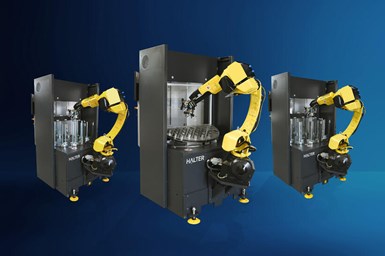Halter CNC Automation Adds Small-Footprint Halter Compact
Halter CNC Automation’s Halter Compact line of loading robots can load and unload up to a 26.45-pound payload while maintaining a small footprint.
Share





Halter CNC Automation has launched the Halter Compact as a small-footprint addition to its existing CNC loading robot line. The Halter Compact has a 26.45-lbs payload and three different models: the TurnStacker Compact for lathes, the MillStacker Compact for milling machines and the Universal Compact for flexible purposes. The TurnStacker Compact can accommodate diameters up to 6.29" (160 mm), while the MillStacker can load workpieces up to 7.87" (200 mm) and the Universal Compact has a long shaft option available for workpieces up to 9.84" (250 mm).
Halter also provides a three-month free demo to test the feasibility of this product. All models are movable by a pallet truck, and the company says the robots also feature easy movement from one CNC machine to another.
Halter CNC’s portfolio of larger CNC loading robots with robotic arms can handle payloads of 44.09, 75.16 and 154.32 lbs. The company says the Halter Compact maintains the quality, ease of use and short changeover times of these existing models while serving as a cost-effective solution for lighter parts.
Loading robots such as the Halter Compact series load and unload parts at production machines – for example, CNC machines. Assigning a robot to place a workpiece inside a CNC machine increases production speeds and protects workers from injury. Also of interest to modern machine shops, loading robots can support lights-off manufacturing. The Halter Compact’s reduction of payload still caters to the range that standard CNC machines can handle.
Related Content
-
Cutting Part Programming Times Through AI
CAM Assist cuts repetition from part programming — early users say it cuts tribal knowledge and could be a useful tool for training new programmers.
-
Generating a Digital Twin in the CNC
New control technology captures critical data about a machining process and uses it to create a 3D graphical representation of the finished workpiece. This new type of digital twin helps relate machining results to machine performance, leading to better decisions on the shop floor.
-
Automated CAM Programming – Is Your Software Really Delivering?
A look at the latest automation tools in Autodesk Fusion 360 software and how forward-thinking machine shops and manufacturing departments are using them to slash delivery times and win more business.






















